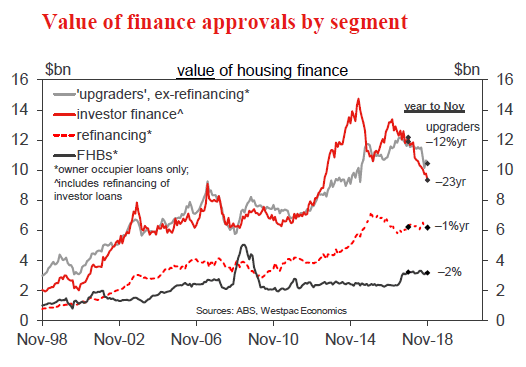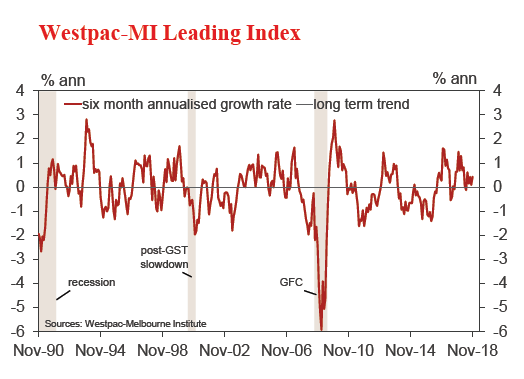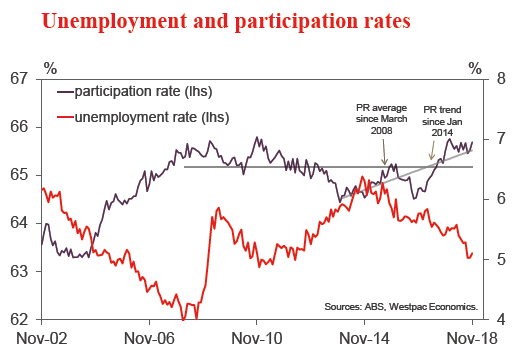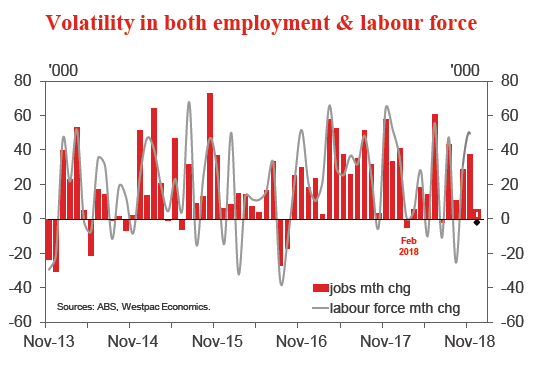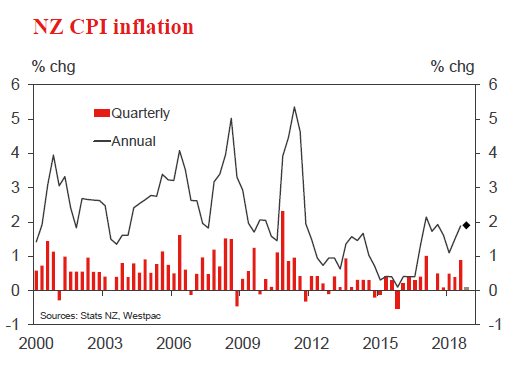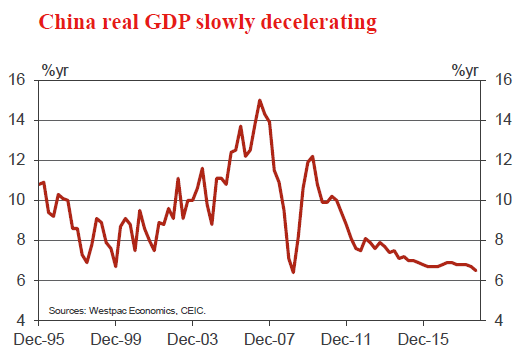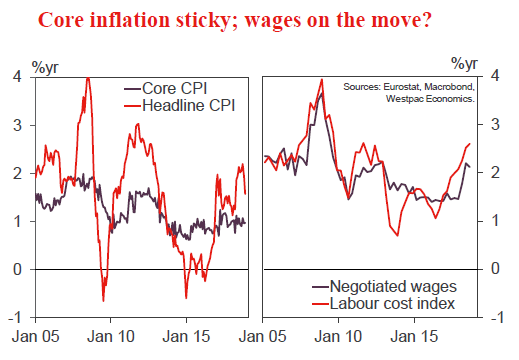Week beginning 21 January 2019
- Australia: Westpac-MI Leading Index, employment.
- NZ: CPI.
- China: GDP, retail sales, fixed asset investment, industrial production.
- Euro Area: ECB policy decision, IFO survey, Davos World Economic Forum.
- US: data delay due to shutdown.
- Other central banks: BOJ, Norges Bank and Riksbank policy decisions.
- Flash PMI’s for Japan, Europe and the US.
- Key economic & financial forecasts.
Information contained in this report current as at 18 January 2019.
The week that was
This week in Australia we received a timely update on consumer confidence. Meanwhile offshore, neither the Brexit malaise or US government shutdown moved any closer to a resolution.
At the start of 2019, Australian consumer confidence soured. Having held above the 100 optimist/ pessimist divide through 2018, our Westpac-MI consumer sentiment survey fell 4.7% to 99.6 in January. All of the key components of the survey deteriorated in the month. The 1 and 5-year forward view of the economy fell 8% and 6%, while views on family finances versus a year ago and for the year ahead also deteriorated, down 6% and 3% respectively.
Household finances and the consequence for consumption are the biggest concerns currently, with both the backward and forward views on finances 5% below their long-run average, and ‘time to buy a major household item’ 7% below.
Whereas the headline index and its components are seasonally adjusted for January, the survey’s additional detail (such as that for the housing market) is not, hence caution is warranted. That said, in this instance, house price expectations from the survey can only be regarded as weak, having fallen another 4% in January to a new cycle low. Unsurprisingly, expectations in NSW and Victoria are the weakest, with nearly 75% of consumers in these states expecting prices to be unchanged or lower in a year. At a time of sub-par income growth, there is a clear and material risk of declining wealth dampening already sub-par consumption growth.
Over in the UK, this week we finally saw the UK Parliament vote on the proposed Brexit deal (agreed by UK and European officials last November). As expected, it was a historic defeat for Prime Minister May. However, PM May subsequently survived a no confidence motion against her Government and is therefore still in charge of finding a solution ahead of the 29 March Brexit deadline.
While the market view this week’s developments as a positive (given their view that they raise the chance of a soft-Brexit or no-Brexit outcome), the reality is that the harshest possible outcome (a no-deal Brexit) is the default result. Reports also suggest PM May is against a softer-Brexit – where the UK stays in the customs union permanently. Negotiations between PM May’s Conservatives and the other parties have begun in pursuit of a compromise, but given PM May’s strident position and Labour leader Jeremy Corbyn’s unwillingness to take part as long as a no-deal Brexit remains a possibility, a near-term deal seems highly unlikely.
European officials are willing to allow an extension of the negotiating period past 29 March, but at this juncture it is not clear this will be productive either. Uncertainty over the UK outlook therefore looks set to remain rife into mid-year, causing the UK economy further material harm.
Turning to the US, this week’s data flow has been very light thanks to the continuing government shutdown – now the longest in history.
Though the shutdown’s real economy impact should be negligible, assuming the government is opened soon and back pay is provided to workers, the mounting backlog of delayed data releases means that the real economy view will remain opaque for some time – potentially even beyond the FOMC’s 19-20 March meeting. This is presumably a key reason the market remains unwilling to price in a significant chance of further tightening by the FOMC in 2019, even as investors become increasingly optimistic over US/ China trade relations, equity markets rally back from their lows and, as made clear by Federal Reserve Governor Quarles overnight, the US’ real economy remains “very strong”.
As evinced by remarks from President Draghi this week, this tension between real economy strength and the long list of global risks is not only at play in the US but also Europe. In both locales, policy setting in 2019 will increasingly occur in the moment, depending on data and risks to hand.
Chart of the week: Australia housing finance
Housing finance approvals softened in November with weakness concentrated in investor loans and the value, as opposed to the number, of owner occupier loans.
The headline number of owner occupier loans held up a little better than expected in the month, recording a 0.9% decline vs consensus and Westpac forecasts of a 1.5% fall. Ex-refi, the number of approvals was down only 0.6%mth. Despite this slightly better than expected complexion to the latest month, weakness is still clear with the number of owner occupier approvals ex refi down 10%yr.
The detail points to weakening investor activity and shrinking average loan sizes as the main driver of weakness late last year – the latter likely reflecting reductions in borrowing capacity following a tightening in bank lending assessments. Notably, the six months to Nov saw a 5.8% drop in the value of owner occupier loans but just a 1.5% decline in the number of loans, the difference being the implied average loan size.
New Zealand: week ahead & data wrap
Mixed messages
With New Zealanders gradually heading home from beaches and holiday spots around the country, the flow of data measuring activity in the New Zealand economy has resumed. This week has been a busy one, with some mixed messages emerging on how the New Zealand economy is tracking as we head into 2019. Separately, likely changes to Reserve Bank regulations have led us to tweak the projected pace of OCR hikes in the early 2020s. But that’s a long way off yet.
The pace of GDP growth has gradually decelerated over the last couple of years and is currently trundling along at around 3%. While the 0.3% growth recorded in the September quarter disappointed relative to expectations, we think 2019 will see a temporary pickup in the pace of activity on the back of a shortlived pickup in the housing market, a lift in government spending and renewed growth in homebuilding. However, it’s fair to say there’s been mixed messages emerging from data released over the first couple of weeks of 2019.
On the soft side, electronic card spending data showed consumers kept a tight rein on their spending over the Christmas period. Electronic card spending shrank 2.3% in the month with core (non-fuel) spending down 1.5%. That’s much weaker than we were expecting. We’re a little suspicious of the extent of weakness in durable spending (where Stats NZ has had issues collecting data in the past) but we wouldn’t entirely discount the possibility that the soft December data genuinely reflect a cooling in households’ spending appetites. Indeed we would note that the weakness wasn’t entirely attributed to durables spending. Spending on other categories, including apparel and hospitality was soft, while there was also a drop in online spending.
Also coming out on the softer side of the ledger this week was December housing market activity. REINZ data showed house sales fell sharply with house sales are now running around 10% lower than a year ago on our estimates. A look at the regional breakdown suggests that the foreign buyer ban (which came into force in October) has played an important role in the fall. The big drop in sales this month was concentrated Auckland, where seasonally adjusted sales dropped 20% in December from a month earlier, and to a lesser extent in Wellington and Christchurch. That matches where foreign buyers are most active (Queenstown Lakes has a high proportion of foreign buyers, but these are often Australians who are exempt from the ban). With a drop in house sales usually a pretty reliable precursor to weaker prices, there’s a risk that we could see house prices in Auckland start falling again in the next few months.
However, the foreign buyer ban is not the only game in town when it comes to the housing market. Indeed for some months now we’ve been expecting to see a modest and temporary pickup in the housing market in the early part of 2019 on the back of the late-2019 drop in fixed mortgage rates and looser LVR lending restrictions from January 1. House prices are rising rapidly in the lower North Island, and even accelerating in Otago and Southland, and that’s even before the full force of the LVR and mortgage rate changes are felt.
On the more positive side of the ledger this week were a suite of confidence surveys. The influential Quarterly Survey of Business Opinion (QSBO) lifted from a nine year low in the December quarter, with firms noticeably less pessimistic about the outlook for the economy over the year ahead. What’s more they also provided a more upbeat assessment of their own activity over recent months.
Although concern about the extreme downside risks to growth posed by plunging business confidence have dissipated somewhat lately, it’s still worth noting that the most useful gauges from the survey still suggest some downside risk to our forecast of 0.8% GDP growth in Q4. And it wasn’t all good news for businesses coming out of the QSBO. In particular, profit margins remain under pressure with firms struggling to pass rising costs onto their customers.
Both firms and workers are reporting a tightening labour market. Firms reported difficulty finding both skilled and unskilled labour increased further in the December quarter which chimes with the Westpac McDermott Miller Employment Confidence Index reaching its highest level since early 2008 in the December quarter.
Rounding off the suite of upbeat confidence reports was a widespread improvement in regional confidence in December. The Westpac McDermott Miller Regional Economic Confidence Index improved across all 11 regions surveyed, with optimists now outnumbering pessimists even in Auckland. Strong rural incomes have been supporting regional confidence in many parts of the country of late and there was further positive news on that front this week. A series of stronger than expected dairy auctions has seen us nudge up our milk price forecast for this season to $6.30 KgMs (previously $6.10).
The final development worth a mention this week is a slight tweak to our projected timing of OCR hikes in the early 2020s. We’re now predicting a slightly slower pace of OCR hikes at this horizon following the Reserve Bank’s announcement late last year of proposed changes to the amount of capital New Zealand banks are required to hold. For those interested in the topic we published an in depth analysis of the impact of the changes (available here) but the key point is that higher capital requirements will lead to a combination of upward pressure on bank lending rates, downward pressure on bank deposit rates, lower GDP and lower return on equity for bank shareholders. The RBNZ would soften the impact of some of these changes via a lower OCR than otherwise. But all this is a long way into the future. We still expect the first OCR hike will be in November 2020.
Data Previews
Aus Dec Westpac–MI Leading Index
- Jan 23, Last: 0.43%
The six month annualised growth rate in the Westpac– Melbourne Institute Leading Index, which indicates the likely pace of economic activity relative to trend three to nine months into the future, rose from +0.10% in October to +0.43% in November. Despite the lift, the broader picture from the measure has been of a slowing in momentum over 2018 from well above trend reads averaging 0.89% over the six months to April 2018 to a more moderately positive 0.24% average in the six months since.
The December index is likely to show a further weakening, with notable declines in both dwelling approvals (-9.4%) and sentiment-based components (Westpac-MI Consumer Expectations Index down 5.6%). With a dip in hours worked and the yield spread narrowing as well, the Leading Index growth rate could even move into negative.
Aus Dec Labour Force Survey – Employment ‘000
- Jan 24, Last: 37.0k, WBC f/c: 5k
- Mkt f/c: 20k, Range: 1k to 30k
Employment was holding a solid pace of growth into yearend with a robust 37.0k gain in November. In the year, total employment lifted 286.0k or 2.3% but the six month annualised pace has lifted to 2.9%yr.
Sample volatility has appeared of late with the ABS noting that the incoming rotation group had a higher employment to population ratio than the group it replaced while the unemployment rate of the incoming rotation group was also higher than the whole sample and the group it replaced.
Business survey’s employment indicators, and jobs ads, have eased back in the last few months but our Jobs Index is still consistent with employment growth of around 2½%yr. Our forecast 5k gain will see a three month average gain of 23.6k (it was 25.4 in Nov) for an annual pace of 2.1%yr.
Aus Dec Labour Force Survey – Unemployment %
- Jan 24, Last: 5.1%, WBC f/c: 5.1%
- Mkt f/c: 5.1%, Range: 5.0% to 5.1%
In Nov there was a surprising jump in unemployment to 5.1% from 5.0% (market median was for 5.0%) due to a 0.2ppt lift in participation to 65.7% (65.69% at two decimal places) which drove a solid 49.5k gain in the labour force.
Again, sample volatility appears to had a role with the ABS noting the unemployment rate of the incoming rotation group was higher than the whole sample and the group it replaced while the participation rate of the incoming group was higher than the group it replaced.
With the return to more average participation we are looking for the reported participation rate to fall to 65.6%, driving a small fall in the labour force (–2k) and holding the unemployment rate flat at 5.1%.
NZ Q4 CPI NZ CPI inflation
- Jan 23, Last: 0.9%, Westpac f/c: 0.1%, Mkt f/c: 0.0%
We expect a 0.1% rise in the Consumer Price Index for the December quarter, which would maintain annual inflation at 1.9%.
The recent volatility in fuel prices will end up having little bearing on the December quarter figures, with the average price over the quarter close to unchanged.
While we expect headline inflation to come in a little below the Reserve Bank’s November MPS forecast, that’s entirely due to the subsequent drop in fuel prices. In contrast, we think underlying inflation will be stronger than the RBNZ’s forecast, reflecting the tightening labour market and the lower New Zealand dollar.
China Q4 GDP
- Jan 21, last 6.5%yr, WBC 6.4%yr
China’s growth pulse has decelerated through 2018. However, it seems likely that the authorities’ target of 6.5% growth will still be achieved, with annual growth to December forecast at 6.4% and the year-average gain expected to come in at 6.6%. In contrast, quarterly growth is likely to be 1.5% (6.0% annualised) or below, as weak investment weighs.
Of course, as is often the case, before the Q4 detail is known, the focus has already shifted to the year to come. Growth then is most likely to be around 6.0% – in line with the anticipated Q4 quarterly outcome.
As evinced by recent real economy partial data and the credit detail, in the months ahead, investment is likely to struggle to accelerate from its current pace. Meanwhile, the strong consumption growth of early-2018 continues to decelerate.
Euro Area ECB policy decision
- Jan 24, deposit rate: -0.4%
In December, the ECB ended net asset purchases and repeated the forward guidance that key policy rates will remain on hold “at least through the summer of 2019, and in any case for as long as necessary”. Reinvestment of their stock of assets will be made in full “for an extended period of time past the date… [of] raising the key ECB interest rates”. The ECB emphasised that guidance is “date contingent” and “state contingent” in a time of “great uncertainty”.
In 2019, the ECB remains cautiously confident. Earlier this week, Draghi gave an upbeat description of the economy: “consumption is still expanding, relatively strong, investment still expanding, supported by our monetary policy, export growth is less, but still good. And the labour market keeps on being very strong.” Yet, he also noted geopolitical uncertainties may continue to weigh on sentiment and drag growth below trend. The ECB will likely need further information before giving more guidance. We see a straightbat ahead of March’s meeting and projection update.




